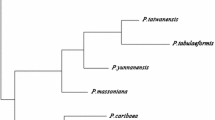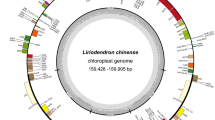Abstract
Background
Crossostephium chinense is a traditional Chinese medicinal herb and it is often cultivated as an ornamental plant. Previous studies on this species mainly focused on its chemical composition and it was rarely represented in genetic studies, and thus genomic resources remain scarce.
Methods and results
Both chloroplast and nuclear polymorphic microsatellites of C. chinense were screened from genome skimming data of two individuals. 64 and 63 cpSSR markers were identified from two chloroplast genomes of C. chinense. A total of 133 polymorphic nSSRs were developed. Ten nSSRs were randomly selected to test their transferability across 35 individuals from three populations of C. chinense, and 20 individuals each of Artemisia stolonifera and A. argyi. Cross-amplifications were successfully done for C. chinense and were partially amplified for both Artemisia species. The number of alleles varied from two to nine. The observed heterozygosity and expected heterozygosity per locus ranged from 0.000 to 0.286 and from 0.029 to 0.755, respectively.
Conclusions
In this study, we developed polymorphic cpSSRs and nSSRs markers for C. chinense based on genome skimming sequencing. These genomic resources will be valuable for population genetics and conservation studies in C. chinense and Artemisia.


Similar content being viewed by others
References
Makino T (1906) Observations on the Flora of Japan. Shokubutsugaku Zasshi 20:en23–en35
Hobbs CR, Baldwin BG (2013) Asian origin and upslope migration of Hawaiian Artemisia (Compositae-Anthemideae). J Biogeogr 40:442–454
Wu Q, Zou L, Yang XW, Fu DX (2009) Novel sesquiterpene and coumarin constituents from the whole herbs of Crossostephium chinense. J Asian Nat Prod Res 11:85–90
Tang F, Chen F, Chen S, Wang XE, Zhao H (2010) Molecular cytogenetic identification and relationship of the artificial intergeneric hybrid between Dendranthema indica and Crossostephium chinense by GISH. Plant Syst Evol 289:91–99
Yang H, Sun M, Lin S, Guo Y, Yang Y, Zhang T, Zhang J (2017) Transcriptome analysis of Crossostephium chinensis provides insight into the molecular basis of salinity stress responses. PLoS ONE 12:e0187124
Lemmens RHMJ (2016) Crossostephium chinense (PROSEA). Published on the Internet; https://uses.plantnet-project.org/e/index.php?title=Crossostephium_chinense_(PROSEA)&oldid=217938. Accessed 24 June 2021
Zhu S, Yilin C, Yousheng C, Yourun L, Shangwu L, Xuejun G, et al. (2011) Asteraceae (Compositae). Flora of China. In: Wu ZY, Raven PH, Hong DY (eds) 20–21
Ryukyu Plant Research Group (2018 onward) Database of Ryukyu plants. Published on the Internet; https://www.kahaku.go.jp/research/activities/project/hotspot_japan/ryukyus/db/. Accessed 24 June 2021
Pelser PB, Barcelona JF, Nickrent DL (eds.) (2011 onwards). Co's Digital Flora of the Philippines. Published on the Internet; www.philippineplants.org. Accessed on: 24 June 2021.
WFO (2021) Crossostephium chinense (A.Gray ex L.) Makino. Published on the Internet; http://www.worldfloraonline.org/taxon/wfo-0000085439. Accessed 27 Jan 2021
Yang XW, Zou L, Wu Q, Fu DX (2008) Studies on chemical constituents from whole plants of Crossostephium chinense. China J Chin Materia Med 33:905–908 ((In Chinese))
Uehara A, Kitajima J, Kokubugata G, Iwashina T (2013) Further characterization of foliar flavonoids in Crossostephium chinense and their geographic variation. Nat Prod Commun 9:163–164
Zhao HB, Chen FD, Chen SM, Wu GS, Guo WM (2010) Molecular phylogeny of Chrysanthemum, Ajania and its allies (Anthemideae, Asteraceae) as inferred from nuclear ribosomal ITS and chloroplast trnL-F IGS sequences. Plant Syst Evol 284:153–169
Drouin G, Daoud H, Xia J (2008) Relative rates of synonymous substitutions in the mitochondrial, chloroplast and nuclear genomes of seed plants. Mol Phylogenet Evol 49:827–831
Yang J, Yue M, Niu C, Ma XF, Li ZH (2017) Comparative analysis of the complete chloroplast genome of four endangered herbals of Notopterygium. Genes 8:E124
Liu LX, Wang YW, He PZ, Li P, Lee J, Soltis DE, Fu CX (2018) Chloroplast genome analyses and genomic resource development for epilithic sister genera Oresitrophe and Mukdenia (Saxifragaceae), using genome skimming data. BMC Genomics 19:235
Kashi Y, King D, Soller M (1997) Simple sequence repeats as a source of quantitative genetic variation. Trends Genet 13:74–78
Jones E, Dupal M, Dumsday J, Hughes L, Forster J (2002) An SSR-based genetic linkage map for perennial ryegrass (Lolium perenne L.). Theor Appl Genet 105:577–584
Varshney RK, Chabane K, Hendre PS, Aggarwal RK, Graner A (2007) Comparative assessment of EST-SSR, EST-SNP and AFLP markers for evaluation of genetic diversity and conservation of genetic resources using wild, cultivated and elite barleys. Plant Sci 173:638–649
Kumar S, Dudley J (2007) Bioinformatics software for biologists in the genomics era. Bioinformatics 23:1713–1717
Xia EH, Yao QY, Zhang HB, Jiang JJ, Zhang LP, Gao LZ (2016) CandiSSR: an efficient pipeline used for identifying candidate polymorphic SSRs based on multiple assembled sequences. Front Plant Sci 6:1171
Chen TT, Du YX, Zhao HD, Dong MF, Liu LX (2019) The complete chloroplast genome of Crossostephium chinense (Asteraceae), using genome skimming data. Mitochondrial DNA B 4:322–323
Kearse M, Moir R, Wilson A, Stones-Havas S, Cheung M, Sturrock S, Buxton S, Cooper A, Markowitz S, Duran C, Thierer T, Ashton B, Meintjes P, Drummond A (2012) Geneious Basic: an integrated and extendable desktop software platform for the organization and analysis of sequence data. Bioinformatics 28:1647–1649
Faircloth BC (2008) Msatcommander: detection of microsatellite repeat arrays and automated, locus-specific primer design. Mol Ecol Resour 8:92–94
Librado P, Rozas J (2009) DnaSP v5: a software for comprehensive analysis of DNA polymorphism data. Bioinformatics 25:1451–1452
Koressaar T, Remm M (2007) Enhancements and modifications of primer design program Primer3. Bioinformatics 23:1289–1291
Kalinowski ST, Taper ML, Marshall TC (2007) Revising how the computer program CERVUS accommodates genotyping error increases success in paternity assignment. Mol Ecol 16:1099–1106
Rousset F (2008) Genepop’007: a complete re-implementation of the genepop software for Windows and Linux. Mol Ecol Resour 8:103–106
Wang W, Chen S, Zhang X (2018) Whole-genome comparison reveals divergent IR borders and mutation hotspots in chloroplast of herbaceous bamboos (Bambusoideae: Olyreae). Molecules 23:1537
Li J, Ye G, Liu H, Wang Z (2020) Complete chloroplast genomes of three important species, Abelmoschus moschatus, A. manihot and A. sagittifolius: genome structures, mutational hotspots, comparative and phylogenetic analysis in Malvaceae. PLoS ONE 15:42591
Iram S, Hayat MQ, Tahir M, Gul A, Ahmed I (2019) Chloroplast genome sequence of Artemisia scoparia: comparative analyses and screening of mutational hotspots. Plants 8:476
Shahzadi I, Mehmood F, Ali Z, Ahmed I, Mirza B (2020) Chloroplast genome sequences of Artemisia maritima and Artemisia absinthium: comparative analyses, mutational hotspots in genus Artemisia and phylogeny in family Asteraceae. Genomics 112:1454–1463
Kim GB, Lim CE, Kim JS, Kim K, Lee JH, Yu HJ, Mun JH (2020) Comparative chloroplast genome analysis of Artemisia (Asteraceae) in East Asia: insights into evolutionary divergence and phylogenomic implications. BMC Genomics 21:1–17
Cho MS, Kim SH, Yang J, Crawford DJ, Stuessy TF, López-Sepúlveda P, Kim SC (2020) Plastid phylogenomics of Dendroseris (Cichorieae; Asteraceae): Insights into structural organization and molecular evolution of an endemic lineage from the Juan Fernández Islands. Front Plant Sci 11:594272
Shen J, Zhang X, Landis JB, Zhang H, Deng T, Sun H, Wang H (2020) Plastome evolution in Dolomiaea (Asteraceae, Cardueae) using phylogenomic and comparative analyses. Front Plant Sci 11:376
Jean Claude S, Park S (2020) Aster spathulifolius Maxim. a leaf transcriptome provides an overall functional characterization, discovery of SSR marker and phylogeny analysis. PLoS ONE 15:4132
Geng QF, Liu J, Sun L, Liu H, Ou-Yang Y, Cai Y, Tang XS, Zhang HW, Wang ZS, An SQ (2015) Development and characterization of polymorphic microsatellite markers (SSRs) for an endemic plant, Pseudolarix amabilis (Nelson) Rehd. (Pinaceae). Molecules 20:2685–2692
Xu J, Hou FY, Wan DR, Wang S, Xu DM, Yang GZ (2015) Development and characterization of polymorphic microsatellite markers for Sedum sarmentosum (Crassulaceae) and their cross-species transferability. Molecules 20:19929–19935
Andrés-Sánchez S, Temsch EM, Rico E, Martínez-Ortega MM (2013) Genome size in Filago L. (Asteraceae, Gnaphalieae) and related genera: phylogenetic, evolutionary and ecological implications. Plant Syst Evol 299:331–345
Siniscalchi CM, Loeuille B, De Siqueira Filho JA, Pirani JR (2019) Chresta artemisiifolia (Vernonieae, Asteraceae), a new endangered species from a recently created protected area in the Brazilian Caatinga. Phytotaxa 399:119–126
Sakata Y, Kaneko S, Hayano A, Inoue-Murayama M, Ohgushi T, Isagi Y (2013) Isolation and characterization of microsatellite loci in the invasive herb Solidago altissima (Asteraceae). Appl Plant Sci 1:1200313
López-Caamal A, Reyes-Chilpa R, Tovar-Sánchez E (2018) Hybridization between Tithonia tubaeformis and T. rotundifolia (Asteraceae) evidenced by nSSR and secondary metabolites. Plant Syst Evol 304:313–326
Liao R, Luo Y, Yisilam G, Lu R, Wang Y, Li P (2019) Development and characterization of SSR markers for Sanguinaria canadensis based on genome skimming. Appl Plant Sci 7:e11289
Kosiński P, Sękiewicz K, Walas Ł, Boratyński A, Dering M (2019) Spatial genetic structure of the endemic alpine plant Salix serpillifolia: genetic swamping on nunataks due to secondary colonization? Alpine Bot 129:107–121
Cao YN, Comes HP, Sakaguchi S, Chen LY, Qiu YX (2016) Evolution of East Asia’s Arcto-tertiary relict Euptelea (Eupteleaceae) shaped by late Neogene vicariance and quaternary climate change. BMC Evol Biol 16:1–17
Zhang CY, Low S, Song YG, Kozlowski G, Van Do T, Li L, Zhou SS, Tan YH, Cao GL, Zhou Z, Meng HH, Li J (2020) Shining a light on species delimitation in the tree genus Engelhardia Leschenault ex Blume (Juglandaceae). Mol Phylogenet Evol 152:106918
Acknowledgements
This research was supported by the National Natural Science Foundation of China (Grant Nos. 31900188, 31970225), Natural Science Foundation of Zhejiang Province (Grant No. LY19C030007). The material was supported by National Wild Plant Germplasm Resource Center for Shanghai Chenshan Botanical Garden (Grant No. ZWGX1902).
Author information
Authors and Affiliations
Contributions
PL designed the study. PL, SS, YF and BJG collected the samples. LXL conducted the laboratory experiments. LXL, SLL, and KK conducted bioinformatic and statistical analyses. All authors drafted and revised the manuscript.
Corresponding authors
Ethics declarations
Conflict of interest
The authors declare no conflict of interest.
Ethical approval
This article does not contain any studies with human participants performed by any of the authors.
Additional information
Publisher's Note
Springer Nature remains neutral with regard to jurisdictional claims in published maps and institutional affiliations.
Supplementary Information
Below is the link to the electronic supplementary material.
Table S1
Locality and voucher information for populations of Crossostephium chinense, Artemisia stolonifera, and A. argyi in this study. Supplementary file1 (DOCX 15 kb)
Table S2
The detail information of polymorphic nSSRs identified for Crossostephium chinense and Primer pairs designed for each polymorphic nSSRs. Supplementary file2 (XLSX 61 kb)
Rights and permissions
About this article
Cite this article
Liu, L., Low, S.L., Sakaguchi, S. et al. Development of nuclear and chloroplast polymorphic microsatellites for Crossostephium chinense (Asteraceae). Mol Biol Rep 48, 6259–6267 (2021). https://doi.org/10.1007/s11033-021-06590-9
Received:
Accepted:
Published:
Issue Date:
DOI: https://doi.org/10.1007/s11033-021-06590-9




